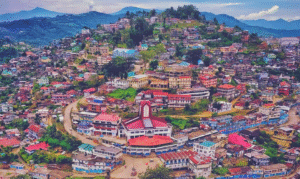Tuophema village is known as the heritage village of Nagaland. Tuophema’s rich culture, tradition, and community portray the many different ways Naga villages sustain themselves. With little over 500 households, this village is a close-knit community. Tuophema’s history is supposed to have begun around 1461 CE.
This Naga village has continued to use its resources to keep the cultural heritage of this area alive. One of the few historical remnants in the village is the ancient northern gate. This traditional village is known for building its own huts which have corrugated iron roofs that are equipped with chimneys to let out the smoke produced by the cooking fires within.
Livelihood
The people of Tuophema rely solely on its natural resources. The land of Nagaland has always provided its inhabitants. For centuries, they have never seen poverty because of their minimalistic living.
Farming
The fertile valleys surrounding Tuophema are home to terraced rice fields, where villagers cultivate their primary crop. They also grow vegetables, fruits, and spices, ensuring food security and income.
Handicrafts
Tuophema boasts a long tradition of skilled craftsmanship. Women weave shawls and bags, while men carve elegant wooden artifacts like sculptures and furniture. These handicrafts are not just beautiful, but also provide additional income and showcase the village’s artistic heritage.
Animal Husbandry
Raising livestock like pigs, poultry, and cattle plays a crucial role in the village economy. They provide meat, eggs, and milk for families, and even income through sales at local markets.
Culture
At the heart of Tuophema’s social life lies the ‘Morung.’ It is a traditional dormitory for young men where they learn valuable life skills, practice hunting, and warfare techniques, and participate in cultural events. The morung fosters a strong sense of community and brotherhood.
Tuophema celebrates festivals like Sekrenyi (harvest festival) and Monyu (warriors’ festival). These celebrations are marked by traditional dances, music, singing, and feasting, bringing the community together in joy and unity.
Music and dance are integral parts of Tuophema’s cultural practices. Villagers play traditional instruments like flutes and drums, while intricate dances like the “warriors’ dance” and the “bamboo dance” are performed during festivals and ceremonies.
The annual Sekrenyi festival, also known as the Angami festival of cleansing, takes place from February 25 to 27. The customs of the festival’s first day demonstrate how important water is to the Angamis. The night before the celebration, the local well is cleaned, and the young people of the village fiercely guard it since nobody is permitted to draw water from it after it has been cleaned. The young guys get up early on the second day and head to the well to wash.
This unique way of living, while respecting the harvest, water, and land is how these villagers have survived for years.
Cuisine
In Tuophema, every meal is a celebration of community, culture, and culinary artistry. The flavors of Dry Pork, Bamboo Steamed Fish, Smoked Pork Stew, and Kongshia Lon are some of the common dishes of this village. Every recipe tells a story of the people, their traditions, and the timeless joy of sharing a meal.
Dry Pork is meticulously dried and seasoned. It creates a savory masterpiece that reflects the community’s love for traditionally preserving meat.
Fish are sourced from nearby rivers to make bamboo steamed fish. It is expertly seasoned and enclosed in bamboo shoots, allowing the natural flavors to meld and infuse into the dish. Smoked pork stew and kongshia ion are two famous delicacies of this village.
These dishes are prepared with precision and care which depicts the essence of the village’s culinary heritage, embracing both the past and the present.
Religion
Today, the majority of Tuophema villagers are Christians, with Baptist and Catholic churches playing a key role in the community. Religious services, hymns, prayers, and faith are a part of their everyday life.
There are still some indigenous beliefs floating around. Traces of pre-Christian animistic beliefs still linger in some aspects of Tuophema’s culture. Practices like offering prayers to ancestral spirits and respecting specific natural sites reflect a connection to the land and its ancient traditions.
Folklore
There are several myths and legends in this area. One of the most common tales revolves around the Themoketsa village and Tuophema village. These are said to be home to two stones that were originally taken from the Thoru River and are thought to represent a husband and wife. The feminine stone, referred to as the Goddess stone, is spherical whereas the masculine stone is flat. There is a hole on the female stone’s side where crimson liquid occasionally seeps out. Since the stones were introduced to the area, Tuophema Village is said to have seen abundant harvests.
Traditions
The Naga tribe follows the Angamu tradition. They wear Angami dresses, headdresses, weapons, and jewellery as a part of their tradition.
Conversing in one’s native tongue fosters interpersonal relationships and a deeper comprehension of one’s background and upbringing. In order to maintain this, the village encourages parents and other adults to instruct and converse with their kids in their native tongue.
Conclusion
Tuophema is a beautiful example of how a village thrives on a strong sense of community, deep-rooted traditions, and a connection to nature. Each Naga village holds unique stories and customs. This place gives us a fresh understanding of their livelihood, culture, and religion.
Amidst a serene landscape, this tiny village is a haven for unconventional living. Each hut, crafted in traditional Naga architecture, stands as a testament to our unique way of life. Rooted in a fearful relation with God, their moral code Kenyu, shapes the daily conduct of the Naga locals. Embracing self-sufficiency, this village is a self-contained universe. It thrives on the strength of its local community. Prohibitions, like guiding principles, safeguard our distinct identity, making this village a place of simplicity and strength.
Unravelling a billion untold stories, one chapter at a time, Humans of Northeast takes you on a discovery through vibrant Northeast India – a land rich in people, places, and culture. Ready to immerse yourself in more such stories? Visit our page HONEI to read more about narratives that inspire and uplift.






